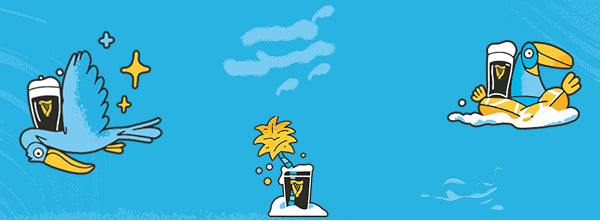FAQs
What are the key ingredients in GUINNESS®?
Our key ingredients - other than inspiration - are roasted malted barley, hops, yeast and water.What is the widget - and how does it work?
Glad you asked. The widget is a plastic moulded device that sits on the top of the contents of each can of GUINNESS® Draught. When the can is opened, a small amount of beer and nitrogen, trapped in the widget, is forced out through the beer, which creates the famous creamy head that you find on a pint of GUINNESS® Draught served in a pub. The widget gives GUINNESS® Draught in cans the taste and texture of a pub-poured pint at home. In GUINNESS® Draught in bottles, the clever little 'rocket' widget floats free in the beer to refresh the creamy head of your GUINNESS® Draught with each swig you take from the bottle.Why is GUINNESS® beer black?
Look closely. GUINNESS® beer is not actually black but rather dark ruby red because of the way the ingredients are prepared. Some malted barley is roasted, in a similar way to coffee beans, which is what gives GUINNESS® beer its distinctive color.What's the percentage of alcohol in GUINNESS® beer?
GUINNESS® Draught is 4.2% GUINNESS® Extra Stout is 4.2% GUINNESS® Foreign Extra Stout is 7.5%What temperature is it served at?
6-7 degrees centigradeHow many calories are there in a pint of GUINNESS® beer?
Per glass there is approximately 99 calories and in a pint of GUINNESS® there is approximately 198 calories. This is actually less than most lagers and spirits.What are the origins of porter?
Porter can trace its origins back to the brewer Ralph Harwood, a London brewer in 1722. This new drink, porter, used roasted barley for the first time and became so popular with the working class porters of Covent Garden and Billingsgate, that it adopted their name - 'Porter'.Does GUINNESS® Draught use the same brewing recipe as Extra Stout?
The recipes for GUINNESS® Draught and GUINNESS® Extra Stout are very similar in all aspects. The difference is that GUINNESS® Draught is dispensed using a mixture of nitrogen and carbon dioxide to produce the famous tight creamy head while GUINNESS® Extra Stout has more carbonation for increased refreshment.Are we drinking the same GUINNESS® today, as in Arthur's day?
Arthur's legacy and his brewing process are still followed by GUINNESS® brewers today. Modern brewing methods enable GUINNESS® to deliver the highest quality products that we are proud to put Arthur's name to today.Is GUINNESS® beer the same in each country?
Generally yes but GUINNESS® does have to use local ingredients so, for example, in Nigeria GUINNESS® is made using sorghum instead of barley. A stronger GUINNESS® beer variant called Foreign Extra Stout is also brewed in Africa and other places.Today the range of GUINNESS® products available includes:
GUINNESS® Draught - the creamy pint, available in keg, bottle and can formats. Typically sold in Europe, the US, Canada and Australia. And as GUINNESS® Draught Extra Cold - available in keg. This is exactly the same as GUINNESS® Draught, but served a few degrees cooler. GUINNESS® Extra Stout/Original - available in bottles and cans. GUINNESS® Foreign Extra Stout - stronger in taste and bitterer than GUINNESS® Draught. It is especially popular in Asia, Africa and the Caribbean.
These beers are all made with the highest quality natural ingredients; all brewed using the same unique and expert GUINNESS® brewing techniques.
Who owns GUINNESS® now / is the family still involved?
GUINNESS® is now part of DIAGEO. The Guinness family is still a shareholder in the company but no family member holds an executive role in the company or works within the Diageo organisation.Is the 9,000 year lease still valid?
The 9,000 year lease signed in 1759 was for a 4 acre brewery site. Today, the brewery covers over 50 acres, which grew up over the past 200 years around the original 4 acre site. The 1759 lease is no longer valid as the Company purchased the lands outright many years ago.What's the significance of the animals / Toucan?
In the 1930s, GUINNESS® was using the advertising agency S.H. Benson. The artist, John Gilroy, was the main artist working on the GUINNESS® contract. The idea to use animals to advertise the GUINNESS® brand came to Gilroy while at Bertram Mills Circus in London. He saw a sealion balancing a ball on its nose and it occurred to him that the animal could probably balance a bottle of stout on its nose too.The toucan was the most popular of all the animals used in the GUINNESS® ad campaign and also the longest lived. He was officially retired in 1982 but still appears on shirts and other memorabilia.
